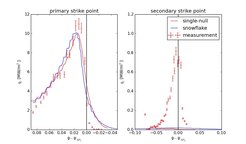Highlights 2014
Research news from the division Plasma Edge and Wall
Snowflake divertor

Presently the most promising design for a fusion reactor is the divertor Tokamak in `single-null' configuration. The heat produced in the central plasma is guided by the divertor legs to the divertor target plates. A big problem is the strong localization of these fluxes that bring the target materials to their heat load limits. The `snowflake divertor', a configuration with two additional divertor legs, is presently discussed as a concept to distribute the heat flux over a larger area. Due to its more complicated topology, however, is was only marginally possible so far to describe this configuration numerically.
In collaboration with the swiss experiment TCV, where this configuration is studied experimentally, the first calculations with EMC3-Eirene, a code developed at IPP, were carried out successfully. It was found that the heat transport to the secondary divertor legs is actually significantly larger than predicted by common models. However, in absolute numbers this effect is of the order of ~10 % only in TCV. Whether this effect becomes larger in a larger device and whether the configuration is suitable for a reactor is a matter of further investigations. This article was published by the journal `Plasma Physics and Controlled Fusion' as an `IOP select'-article:
T. Lunt et al. 2014 Plasma Phys. Control. Fusion 56 035009
